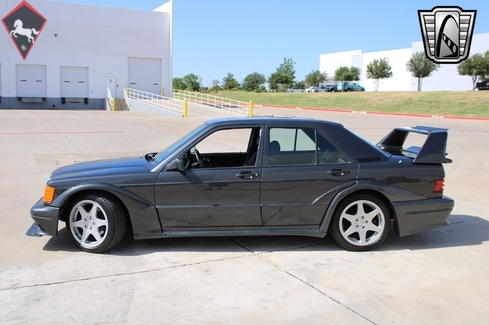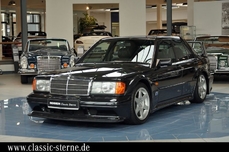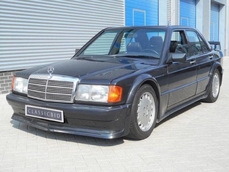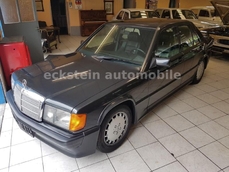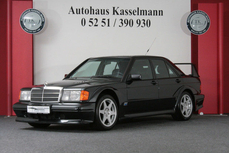Mercedes-Benz 190 2.5-16 Euro 2.5-16V 2.5-16V Cosworth 2.5L Inline 4 I4 1985
General description :
Mileage : 112099
Interior Color : Black
Exterior Color : Grey
VIN : WDB2010341A182331
Transmission Description : Evo Dogleg 5 Speed Manual
Doors : 4
Description : Gateway Classic Cars of Dallas is excited to present this sharp 1985 Mercedes-Benz 190E Euro Evolution II Tribute. This unique Mercedes was imported into Florida in February and has been enjoyed by the current owner since March. According to the Carfax report, this car is accident-free and has had the body altered for its current appearance. Walking around this sharp Mercedes one should notice the gray metallic gloss paint offset with painted alloy 17" Evo II wheels wrapped in New Michelin Pilot Sport radial tires. Adding to the curb appeal are the Evo body kit, Evo exhaust, side body molding, front splitter, etc. The famous rear wing alone visually cued the "EVO II" as the brand's top-tree offering when it came to its sports car line-up. The rather box-shaped aerodynamic piece was developed by Rdiger Faul (Mercedes-Benz) and Professor Richard Lpple (Stuttgart University of Technology). A front spoiler was also fitted and could be adjusted. The interior has been altered to keep the Evo II in mind with bucket seats, carbon fiber inserts, and an Evo Dogleg 5-speed manual shifter. Powering this '85 is a 2.5L 16 valve Cosworth Inline 4 cylinder with the swapped-in Evo transmission. The odometer reads just over 112k Kilometers. If you are looking for the style of the Evo II without breaking the bank, this could be the one for you.
This 1985 Mercedes-Benz 190E Euro Evolution II Tribute is listed by our Dallas Showroom and can be viewed in greater detail including 100+ HD pictures and an HD video at http://www.GatewayClassicCars.com. For additional information, please call our knowledgeable staff at (817)-310-9400 or email us at Dallas@GatewayClassicCars.com. Our Dallas Showroom is located at 1250 Mustang Drive Suite 500, Grapevine, TX 76051. Hours: Monday through Saturday, 9 AM to 5 PM EST, please reach out to set an appointment.
See more at: http://www.gatewayclassiccars.com/DFW/2108/1985-Mercedes-Benz
https://www.gatewayclassiccars.com/vehicle/DFW/2108/1985-Mercedes-Benz-190E
1985 Mercedes-Benz 190 2.5-16 Euro 2.5-16V 2.5-16V Cosworth 2.5L Inline 4 I4 is listed sold on ClassicDigest in DFW Airport by Gateway Classic Cars for $54000.
Car Facts
Car type : Car Make : Mercedes-Benz Model : 190 2.5-16 Model Version : Euro 2.5-16V 2.5-16V Cosworth 2.5L Inline 4 I4 Engine size : 2.5 Model Year : 1985 Location : Dallas
Sold
Seller Information
Sold
People who viewed this Mercedes-Benz 190 2.5-16 also viewed similar Mercedes-Benz listed at ClassicDigest
Other cars listed for sale by this dealer
About Mercedes-Benz
In the annals of automotive history, the journey of Mercedes-Benz is a tale that unfolds with the ingenuity of its founding pioneers. In the year 1886, Karl Benz crafted the Benz Patent Motorwagen, a creation that would go down in history as the world's inaugural automobile. Unbeknownst to him, this moment marked the genesis of what would evolve into the most illustrious premium car manufacturer globally. The financial underpinning of this pioneering venture, interestingly, was provided by Karl Benz's wife, Bertha Benz, demonstrating a remarkable partnership that would set the tone for Mercedes-Benz's legacy.A parallel narrative emerged not far away, as Daimler-Motoren-Gesellschaft, founded by Gottlieb Daimler and Wilhelm Maybach, entered the scene. In 1901, they unveiled their automobile under the now-famous moniker "Mercedes," meaning "godsend" in Spanish. This name was bestowed upon the car at the behest of Emil Jellinek's daughter, the distributor for Daimler-Motoren-Gesellschaft. The wheels of innovation were set in motion.
Fast forward to 1926, a pivotal year that witnessed the merger of Daimler with Benz & Cie., culminating in the birth of Daimler-Benz. The amalgamation saw the adoption of "Mercedes-Benz" as the distinguished trademark for their automobiles, fusing the legacies of two visionary entities into one.
Contrary to perceptions of conservatism, the trajectory of Daimler-Benz unfolds as a chronicle of industry firsts. From the introduction of the honeycomb radiator to the float carburetor, and the pioneering implementation of four-wheel brakes in 1924, Daimler-Benz consistently pushed the boundaries of automotive innovation. The diesel-powered Mercedes-Benz 260 D in 1936 marked the inception of diesel engines in passenger cars. The iconic Mercedes-Benz 300SL Gullwing made history as the first car with direct fuel injection, albeit the Gutbrod's tiny 2-stroke engine can claim precedence.
Safety innovations became a hallmark, with Béla Barényi's patented safety cell design in the "Ponton"-models in 1951, featuring front and rear crumple zones. The W116 450SEL 6.9 saw the introduction of the Anti-Lock Brake system (ABS), another pioneering safety feature. From the first production airbags and beyond, the legacy of "firsts" continued to be etched into the fabric of Daimler-Benz.
Over its centennial journey, Mercedes-Benz has not merely produced cars but has sculpted automotive icons. The SSKL, 710 SSK Trossi Roadster, 770K Grosser, 540K Spezial Roadster, 300SL Gullwing, w100 600 Pullman, w111 280SE 3.5 Flachkühler, w113 230SL Pagoda, w109 300 SEL 6.3, and w201 2.3-16 Cosworth stand testament to the brand's commitment to engineering excellence.
The roaring Silver Arrows, or "Silberpfeile," including the W 25, W 125, W154, W165, and W196, created a legacy of dominance on the racetrack. These machines were not merely cars; they were expressions of precision, speed, and an indomitable spirit that left their competitors in the dust.
As Mercedes-Benz marches into the future, it does so not just as an automaker but as a custodian of a legacy, a torchbearer of innovation, and a beacon of automotive excellence. The road ahead is sure to witness the continued fusion of cutting-edge technology, timeless design, and an unwavering commitment to setting new standards in the world of automobiles.
One luminary figure who left an indelible mark was Béla Barényi, often heralded as the "father of passive safety" for his pioneering work in safety engineering. His patented safety cell design, featuring front and rear crumple zones, became a hallmark of Mercedes-Benz's commitment to occupant safety, setting new standards that reverberated throughout the automotive world.
Moving through the chronicles, the collaborative genius of Wilhelm Maybach, alongside Gottlieb Daimler, laid the foundation for Daimler-Motoren-Gesellschaft. Their innovations not only birthed the first Mercedes but established a culture of relentless pursuit of technological excellence that remains integral to Mercedes-Benz's DNA.
In the post-merger era of 1926, Ferdinand Porsche emerged as a prominent figure within Mercedes-Benz. His work on the Mercedes-Benz S-Type, a supercharged race car, garnered acclaim and set the stage for a legacy that extended far beyond the marque. Porsche's impact would later extend to his eponymous company, but his influence at Mercedes-Benz during those formative years was pivotal.
As the 20th century progressed, the legendary Rudolf Uhlenhaut emerged as a key figure. Uhlenhaut, an accomplished engineer and the driving force behind the iconic Silver Arrows, played a crucial role in Mercedes-Benz's dominance in motorsports. His engineering prowess and attention to detail were instrumental in creating some of the most formidable racing cars of the era.
In the latter half of the century, figures like Bruno Sacco, the head of design at Mercedes-Benz from 1975 to 1999, left an indelible imprint on the brand's aesthetic identity. Sacco's design philosophy, characterized by clean lines and timeless elegance, shaped iconic models like the W126 S-Class and the W201 190E, solidifying Mercedes-Benz's reputation for luxury and sophistication.
The narrative would be incomplete without acknowledging the contributions of engineers like Hans Scherenberg, whose leadership in the 1970s ushered in a new era of technological innovation at Mercedes-Benz. Scherenberg's tenure saw the development of groundbreaking technologies, including the Anti-Lock Brake system (ABS) and the introduction of airbags in production cars.
